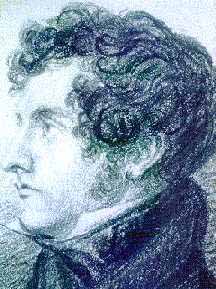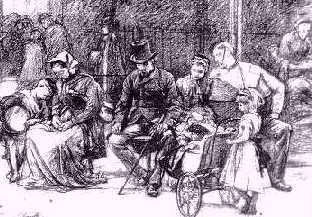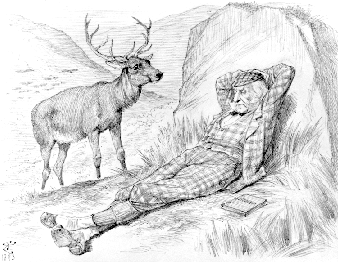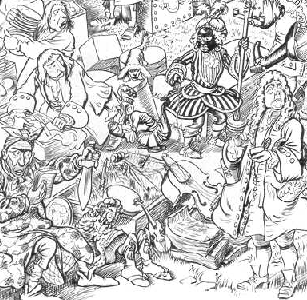Life Lines
Drawings & Cartoons from the University Museum Collections
June - October 2001
Displayed at the University Library in Small's Wynd, this exhibition provides a unique opportunity to see some of the most simple but delightful works of art in the University Museum Collections. Although the style and content varies considerably, each work reveals an artist who has the ability to re-create life with just a few lines on paper.
On this page we have reproduced some of the images on display

David Scott (1806-1849)
Sir John Steell
The son of an Edinburgh engraver, Scott studied at the Trustees' Academy and was soon painting unusual historical scenes, which saw him elected to the Royal Scottish Academy in 1830.
The following year he published The Monograms of Man, a series of engravings revealing a pessimistic view of the life of Man. He also produced illustrations for Coleridge's Rime of the Ancient Mariner.
His paintings could be vast in scale, and are dark and brooding in style. Scott's work was never commercial, and he died prematurely.
This portrait is of Sir John Steell, a sculptor responsible for some of Scotland's most famous works of public art, including the statue of Burns in Albert Square, Dundee.

John Doyle (1797-1868)
Irish Funeral
A caricaturist who always signed himself "H B", Doyle came to London from Ireland and soon made his name drawing caricatures of leading Members of Parliament.
His political satires (as the writer Thackary put it) "cause one to smile in a quiet, gentlemanlike kind of way."
His grandson was the creator of Sherlock Holmes, Sir Arthur Conan Doyle.

George John Pinwell (1842-1875)
Seat in St James Park, or Hard Up
One of the most successful illustrators of the 1860s, Pinwell contributed to magazines like Punch and Good Words, and illustrated such popular books of the day as Dalziel's Arabian Nights and Wayside Posies. He favoured a realist style and outdoor scenes such as this were one of his particular strengths.

David Waterson (1870-1954)
Old Coull
This engraving by the Brechin artist David Waterson shows the intensity of expression that can be achieved using only black on white. Waterson was also a keen entomologist, and the University owns a collection of his watercolour insect studies.

Alphonse Legros (1837-1911)
Dr C Hitchcock
Born in France, Legros grew up in poverty but found success as a teacher at the Slade School of Art in London, where he had a great influence on his students (although Pissarro, whose son worked under Legros, was highly dubious about his methods). He was certainly a fine draftsman, as this portrait demonstrates.
Cartoons
The word "cartoon" derives from the Italian cartone, meaning paper. It was originally used to refer to an artist's preliminary sketch for a large painting or design. The works in this exhibition by Rossetti and Leighton would have been described as cartoons, but are now known as studies.
"Cartoon" acquired its modern meaning in 1843, when Prince Albert devised a competition to design frescoes for the new Houses of Parliament. An exhibition was held of the entries, and this was lampooned by the popular magazine Punch, for which John Leech drew a series of satirical imitations.
Pictorial satire had existed long before it was given the name "cartoon". In Flanders, Breugel's grotesque and symbolic paintings of the 16th century were an early prototype, and many Italian artists of the 17th century used visual allegories to make satirical statements. In the 18th century the genre flourished in Great Britain and the Netherlands.

Sir John Tenniel (1820-1914)
Over the Hills and Far Away
The son of a dancing master, Tenniel attended the Royal Academy but soon left, unhappy with the quality of teaching. His first major commission was a fresco for the House of Lords, and in 1850 he was asked to join the staff of Punch. He considered himself a serious artist, however, and was initially reluctant to take the post. He made a great success of it, however, and eventually became the magazine's chief cartoonist. It also led to his most famous work, the illustrations for Lewis Carroll's Alice books.
Tenniel was blind in one eye and drew solely from memory. He often arranged meetings with leading politicians in order to study their faces, and was once honoured by an invitation to 10 Downing Street to get a close look at Prime Minister William Gladstone. This cartoon (for an 1893 issue of Punch) is one of the results, but apparently the Liberal Gladstone was not pleased with the way Tenniel (a Tory) portrayed him, and he was not invited again. Gladstone did, however, give Tenniel a knighthood. He retired from Punch in 1901.

Sir Bernard Partridge (1861-1945)
The Chef
Partridge replaced Sir John Tenniel as chief cartoonist of Punch in 1901, having been on the staff since 1892. Partridge's father was a teacher at the Royal Academy, but his son initially chose the theatre as his occupation. Many of his early Punch cartoons were for reviews of plays. He had strong political views, however, and was scathing in his attacks on Labour and the trade unions in particular.
This cartoon was drawn for a 1921 issue of Punch, and parodies the Prime Minister Lloyd George. Many critics now consider Partridge to be Punch's finest artist, but he considered himself to be "little more than a hack draughtsman."

Caran d'Ache (1858-1909)
detail from Ancient Warfare
Caran d'Ache was the pseudonym of Emmanuel Poire, one of the leading French cartoonists of the late 19th century. Born in Moscow, his grandfather was a soldier in the Napoleonic Wars. Poire also entered the army, and moved to France in 1877. He began publishing military caricatures in 1880, and was soon working for leading magazines like Le Figaro and Chat Noir. By producing works in a series with narrative elements, Poire became one of the pioneers of the comic strip. His last work, Maestro, remained unfinished at the time of his death, and was finally discovered and published in 1999.